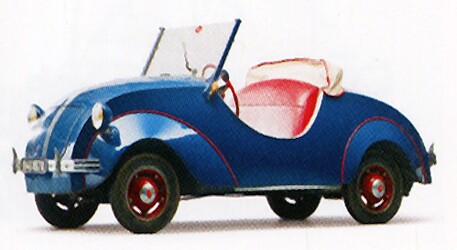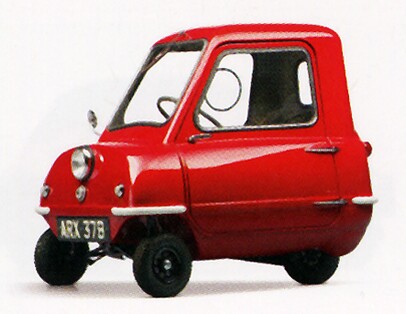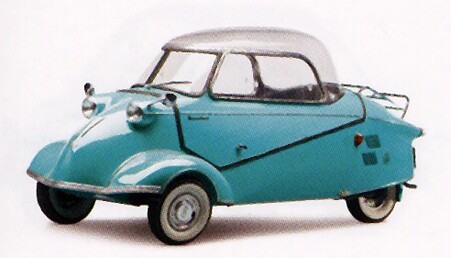Investing in Microcars
10 Stocks to Hold Forever
One Great Juice Stock
---
How would you like to own this car?
1947 ROVIN D2
Or this one?

1959 SCOOTACAR MK 1
You can, if you attend the auction at Bruce Weiner’s Microcar Museum in February--and you bid high enough!
Who’s Bruce Weiner and what’s a microcar?
Well, you might call Bruce Weiner a bubblegum mogul.
Beginning with gumball machines, the mechanically minded man acquired interests in four companies in the confectionery industry, one of which was the maker of Dubble Bubble chewing gum. Bruce grew his companies well, traveling the globe to keep tabs on factories and work new business deals.
And on many of these trips, he took side trips to seek out and acquire microcars, eventually amassing more than 300.
Bruce’s salary in 2003 was roughly $3 million, so he could well afford them.
Microcars, generally, are cars built in Europe in the decades after World War II, with three or four wheels and engines of 700cc or less. Most have two doors or less and seat at least two people. They’re not the kind of car you’d want to take on an American highway.
Yet they were an economically appropriate solution in post-war Europe where cash was short, fuel costs were high, and many people either didn’t have driving licenses or wanted to escape paying the tax on a real car.
But among collectors, they’ve never commanded the respect of “real cars,” and my sense is that Bruce Weiner’s auction may change that.
First, because this is the largest collection of microcars ever built, and it’s all being sold, along with such miscellany as vending machines, neon signs and model cars. And there’s no reserve on anything! Everything will go!
Second, because the auction is being run by RM Auctions, which routinely auctions Ferraris, Duesenbergs and Bugattis for millions of dollars. (My friend Don Rose, who’s a car specialist at RM, gave me the auction catalog.)
And third, because untold numbers of people are still intent on acquiring “things” as protection against the collapse of the global financial economy, or simply as protection against the volatility of stocks.
Admittedly, these aren’t the hedges that million-dollar cars can be, but for small-time auto buffs, they’re something. And they’re cute!
So my sense is that the same forces that have driven up prices for gold, silver, gems, antiques, wine, fine art and collectible cars over the past decade might well create record prices for these little cars as well. Without doubt, that’s what RM is counting on.
And so, I assume is Bruce Weiner.
Bruce doesn’t need the money. In 2004, he sold his interest in Dubble Bubble and associated companies to Tootsie Roll Industries (TR) for $217 million (before taxes).
But because his microcar collection is substantially complete after 22 years, and there’s nothing more to buy, Bruce is looking to cash out and pursue new interests.
Now, when Bruce was acquiring these microcars, especially back in the 1990s, when people were going gaga over stocks, demand for stuff was relatively low. You can be sure the prices he paid were minuscule compared to what RM hopes to get.
But by putting together the world’s largest collection, restoring most of them to concours quality, and displaying them in a museum, he has (RM hopes) turbocharged the market to a level few people could have imagined ten years ago.
And he’s selling into the right climate.
$insert("/sitecore/content/ads/ID/2012-12-Top-Picks”,"wc21")
So let’s talk prices.
The smallest car in Bruce’s collection--the smallest car ever put into production--is the Peel P50, which has three wheels and no reverse gear. To get out of a parking spot, you simply grab the handle at the back end (where the single wheel is), lift, and turn the car around.
1964 PEEL P50
Its estimate is $35,000 to $45,000.
The most expensive car at the auction might be the 1959 Goggomobil TL-400 Transporter Pickup adorned with Coca-Cola logos. Its estimate is $100,000 to $125,000.
GOGGOMOBIL TL-400
But you might get the 1947 Rovin D2 shown at top for $30,000. Or the 1959 Scootacar for $20,000. Or a 1959 Messerschmitt--the best-engineered of them all, according to some people--for $50,000.
1959 MESSERSCHMITT KR 200
But maybe those prices are too high! Maybe not enough bidders will show up in Georgia. And maybe--because everything is being sold without reserve--you’ll get lucky!
Me, I like looking at them. I’d like driving them. And I may even go to the auction preview; after all, I’ve got the catalog, which grants entry. But I don’t want to buy them, especially at what might be a top in the market. I’m sticking with stocks, not least because I think there are some great bargains out there.
More on that below.
$insert("/sitecore/content/ads/SOM/2012-01-Play-the-market”,"wc21")
Last week I began a series titled “10 Stocks to Hold Forever,” in part because the 10 stocks my editors chose back in 2007 have gained an average of 52.4%, while the S&P 500 has LOST 2% over the same period.
You can read background info on the theory and strategy here.
Today I’m bringing you the second stock (alphabetically) in the list of “Stocks to Hold Forever” my editors chose last month.
It’s Jamba Juice (JMBA), and it was selected by Tom Garrity, editor of Cabot Small-Cap Confidential.
For the record, Tom’s average gain on stocks sold since he became editor of Cabot Small-Cap Confidential just over five years ago is 30.5%. That’s very impressive, and I see no reason JMBA can’t do the same.
Jamba Juice was founded in California in 1990, as a maker of smoothies. From one shop, the company grew to hundreds, and in 2006, the original management team sold out to an investment group for $265 million.
Today, six years later, the stock’s market capitalization is $170 million (compared to revenues of $229 million), so it’s obvious that something went wrong.
Most notable is the fact that Jamba hasn’t had a profitable year since 2007!
Yet Jamba remains the #1 nationally recognized name in the smoothie business, with roughly 770 retail outlets in more than 20 states, the Bahamas, Canada, Korea and the Philippines.
Tackling the problem, management has instituted a number of major changes (some of which will take time), but Tom is confident that patience will pay, and that if you buy now, while the stock is cheap, you’ll be amply rewarded.
Here’s some of what Tom wrote:
“On December 1, 2008, Jamba took its first steps toward righting its sinking ship by appointing CEO James White. White proceeded to outline and implement a pair of business models/strategies titled “Blend 1.0" and “Blend 2.0.”
“Blend 1.0, the first stage in Jamba’s turnaround plan, was implemented between 2009 and 2011. This first stage was designed to achieve the following goals: accelerate the development of franchise stores and non-traditional stores, expand the menu across all parts of the day, and license and build a consumer packaged goods (CPG) line. Much of how Jamba operates today sprang from Blend 1.0--from Jamba’s expanded menu offerings to the company’s increased community involvement and focus on customer health.
“This portion of the company’s turnaround plan was also responsible for Jamba expanding into nontraditional markets, including K-12 schools and college campuses. In fact, with colleges and K-12s turning away unhealthy beverages, Jamba is being viewed as a solution to fill those service gaps. The company’s storefront flexibility--i.e., kiosks and smaller stores--has allowed Jamba to develop a robust franchising program with higher yields and lower capital expenditures. Along those lines, Jamba has also accelerated development of franchises, entering into agreements with Max’s Group, SPC and Canadian Juice Corp., which sports more than 1,200 stores in 25 countries. Internationally, Jamba’s retail partners have signed on to open 320 stores during the next 10 years.
“Furthermore, Jamba has also built brand recognition via product licensing agreements with Nestle and Inventure Foods. Around 2008, Jamba and Nestle agreed to develop energy drinks, with the partnership leading to three commercial offerings: Strawberry Banana, Crisp Apple and Pomegranate Blueberry. Meanwhile, Inventure licenses Jamba’s ready-to-blend smoothie kits, which reproduce versions of Jamba favorites like Razzmatazz, Mango-a-Go-Go and Strawberries Wild.
“Jamba expects that revenue from its expansion into retail consumer markets will reach $1 billion from royalties, licensing and joint venture consumer products by 2016.
(Note: If this company is doing $1 billion in licensing, etc. by 2016, its stock will go through roof! But Tom doesn’t write like that.) Going on, he wrote:
“The successor to Blend 1.0, Blend 2.0 is designed to expand upon Jamba’s product line as well as its points of distribution, with the stated goal of reaching 50,000 retail locations. Furthermore, the company intends to expand its current offering to 35 product lines. Jamba is also looking to expand and improve its menu offerings, including Fit ‘n Fruitful Smoothies and Pre-Boost Smoothies.
“As a final component to Blend 2.0, Jamba is ramping up its “Jamba Go” self-service freestanding offerings. The Jamba Go concept is designed to provide K-12 schools, convenience stores, colleges and entertainment centers with Jamba smoothie dispensing units. At present, Jamba feels it can place 400-500 units in schools alone, with the potential to expand to more than 1,000 units eventually. As an investment choice in a healthier America, Jamba is a keeper. The company is already decades ahead of any existing quick-serve restaurant when it comes to offering a healthy menu.
“Unlike most other fast food restaurants dotting the countryside, Jamba’s menu items can claim they’re both tasty and healthy. The company uses only high quality ingredients, avoiding artificial preservatives, trans fats, high fructose corn syrup and artificial preservatives. In order to ensure the highest quality of healthy offerings, Jamba has taken its food selection one step further by employing food scientists, quality assurance specialists and other food industry gurus. And while nearly anyone can open a smoothie shop, Jamba differentiates itself by infusing its brand and company culture with an overriding sense of health consciousness.
“From Jamba’s store ambiance to its knowledgeable general manager, shift managers and team members, the company exudes a deep expertise in nutritious health. In fact, all Jamba associates are encouraged to develop and practice healthier eating and lifestyle habits consistent with the company’s image. Jamba’s mantra is that the company--from its buildings and its policies down to its employees--should embody its product platform of healthier drinks (smoothies) and food items. By doing so, Jamba has ultimately instilled a sense of brand loyalty in its customers by engaging them with a message of healthier living, or, “living fruitfully.”
When Tom’s initial recommendation was published back in June, JMBA was trading at 1.84. Last week it topped 2.25, for a six-month gain of 22%, which is very good. But Tom thinks there’s far more upside for the stock.
And he’s not alone. Turns out that analysts are expecting Jamba to turn a profit in 2013, with the average estimate being $0.08 per share!
Most recently, in November, Tom wrote that Jamba “announced its intent to expand throughout its home state of California with a growth plan that includes the opening of up to 120 new Jamba Juice stores in select territories across northern, central and southern California over the next six-to-seven years.”
If you like the idea, you could just plunge in and buy JMBA here. But what I really suggest is checking out Tom’s Cabot Small-Cap Confidential, so you can see all his recommendations--including his recommendation on when to take profits in JMBA.
Yours in pursuit of wisdom and wealth,
Timothy Lutts
Editor of Cabot Stock of the Month
---
[author_ad]






